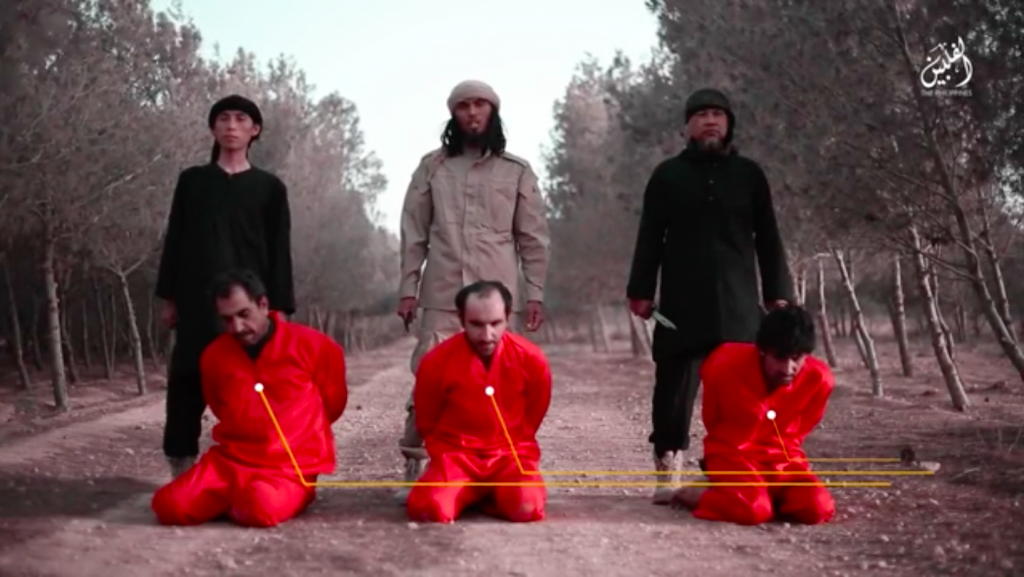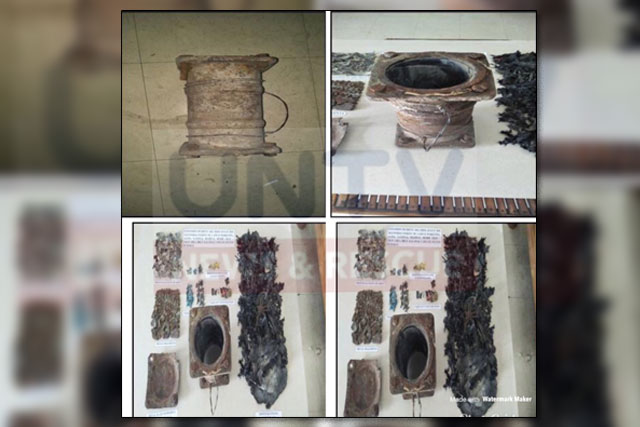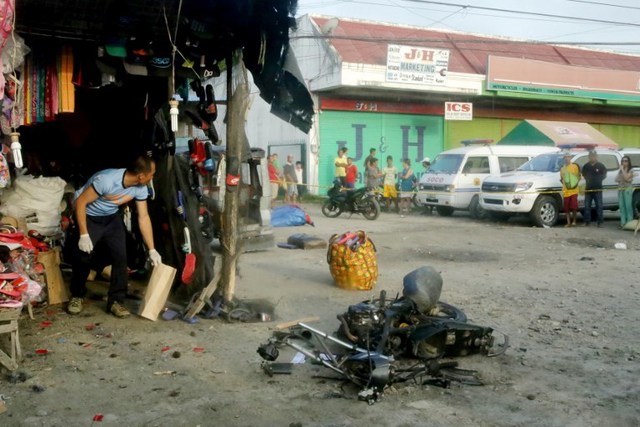From the FDD's Long War Journal (Aug 27):
Analysis: US terror designations target Islamic State’s Southeast Asian network
 Three newly-designated terrorists appeared in a June 2016 video entitled, “The Solid Edifice – The Philippines.”
Three newly-designated terrorists appeared in a June 2016 video entitled, “The Solid Edifice – The Philippines.”On Aug. 24, the US Treasury Department
announced that it had designated three Islamic State recruiters from Southeast Asia as terrorists. The move is the latest in a series of designations targeting jihadists from Malaysia, Indonesia and the Philippines who joined Abu Bakr al-Baghdadi’s caliphate building project.
The three newly-sanctioned Islamic State recruiters are: Mohamad Rafi Udin, Mohammed Karim Yusop Faiz and Mohammad Reza Lahaman Kiram. All three were “were featured in an official ISIS beheading video” and used the gory executions to buttress their call to jihad, encouraging would-be recruits to join the self-declared caliphate’s ranks. The video in question, titled “The Solid Edifice – The Philippines,” was released in June 2016. It was part of the group’s aggressive push to woo additional people from throughout Southeast Asia to its cause, including some who were previously aligned with al Qaeda.
Treasury describes Udin as “the most senior Malaysian ISIS leader in Syria” as of Nov. 2017. Udin has had a lengthy career waging jihad, with Treasury dating his “militant activities” to 1998. He was “arrested and detained from 2003 to 2006 for fighting on behalf of Jemaah Islamiyah (JI),” an al Qaeda-affiliated group whose membership gravitated toward Baghdadi’s cause.
Udin relocated to Syria in 2014, appearing alongside Faiz and Kiram in the June 2016 beheading video. In that same video, according to Treasury, Udin called upon Muslims to pledge allegiance to Baghdadi and also encouraged “individuals in the Philippines to join together under the command of now deceased Isnilon Hapilon.” Hapilon previously led the Abu Sayyaf Group (ASG), another al Qaeda-linked group that joined the Islamic State after its caliphate declaration. According to authorities, Hapilon was killed in Marawi in 2017.
Like Udin, Faiz traveled to Syria in 2014 and was also previously imprisoned years before joining the Islamic State. Treasury says Faiz, an Indonesian, was jailed “in the Philippines for nine years on charges of illegal possession of explosives and weapons.”
Kiram, who is from the Philippines, relocated to Syria along “with his wife and daughter in 2015.” Treasury says he “was a member of a Philippines-based militant group that pledged alliance to ISIS” and trained “recruits in 2014.” Police in the Philippines suspect Kiram “was responsible for the Zamboanga, Philippines bus bombing in 2012.”
Previous US designations targeting the Islamic State’s Southeast Asian networkSince 2015, the US has issued a string of designations targeting the Islamic State’s network stretching from Southeast Asia all the way to Iraq and Syria. The evidence cited by the US government in these previous matters indicates that the organization’s Southeast Asian branches have not merely adopted the Islamic State’s notorious branding, but are instead connected to Baghdadi’s mother organization in various ways.
The ties have been a two-way street. Personnel based in Southeast Asia have sent recruits off to fight for the caliphate’s cause. Meanwhile, jihadists who relocated from the region to Iraq and Syria have facilitated the transfer of funds back to their compatriots and also provided specific guidance on terrorist plots.
On Sept. 29, 2015, Treasury
added two Indonesians to the US government’s list of designated terrorists. The two are Tuah Febriwansyah and Muhammad Sholeh Ibrahim. Febriwansyah (also known as Muhammad Fachry) helped build the Islamic State’s organizational capacity inside Indonesia. Jemmah Anshorut Tauhid (JAT) was one of the many Indonesian extremist groups influenced by the rise of Abu Bakr al Baghdadi’s enterprise. In mid-2014, according to Treasury, JAT “leaders sought Febriwansyah’s support to bolster JAT during a schism over allegiance to” the Islamic State. Officials credited Febriwansyah and his comrades with recruiting “as many as 37 Indonesians on behalf of” the so-called caliphate. Febriwansyah was arrested on March 21, 2015. The other jihadist, Ibrahim, served as a senior JAT leader and swore allegiance to the Islamic State in 2014.
On Jan. 10, 2017, Treasury
added two more Indonesians to the US government’s list of terrorists. The first, Bachrumsyah Mennor Usman, left for Syria “at the end of March 2014.” He went on to serve the Islamic State in senior roles and lead one of its main Southeast Asian fighting groups, Katibah Nusantara, in Syria. From his position inside the lands of the caliphate, Usman was implicated in plots in his native Indonesia. Treasury reported that, in early 2016, Usman “had transferred $105,000 to the leader of a group of terrorists in Indonesia.” This unit was known as the “Bekasi cell.” The Islamic State “ordered that the money” transferred by Usman “be used to carry out attacks in Indonesia” and Usman had “ordered an associate to plan attacks similar to the January 14, 2016 bomb attacks in Jakarta.” Usman also funneled additional funds to the Philippines.
Oman Rochman, an influential ideologue, was
designated alongside Usman. Even though he was imprisoned, Rochman was “likely communicating with [Islamic State] leaders in Syria” as of early 2016. From behind bars, Rochman played a major role in disseminating the Islamic State’s propaganda throughout Indonesia and also “authorized” the Jan. 14, 2016 attacks in Jakarta. The Islamic State
claimed responsibility for those same attacks. At one point, Rochman “required” recruits to receive his personal endorsement before traveling to Syria to join Baghdadi’s enterprise.
The State Department also issued a
terrorist designation for Jamaah Ansharut Daulah (JAD) on Jan. 10, 2017. JAD “was formed in 2015” when nearly “two dozen Indonesian extremist groups” joined together to pledge allegiance to Baghdadi. The JAD provided the muscle for the Jan. 2016 Jakarta operation.
On Mar. 30, 2017,
Treasury named Bahrun Naim, an Indonesian, and Muhammad Wanndy Bin Mohamed Jedi, a Malaysian, as specially designated global terrorists. The two were
tied to a number of plots inside their respective home countries. From their safe havens in Iraq and Syria, the pair remotely guided various cells. [See FDD’s Long War Journal report,
Indonesian authorities hunt Islamic State operative’s cyber recruits.]
On Feb. 9, 2018, Treasury designated
Abdulpatta Escalon Abubakar, an Islamic State bagman who was detained by Filipino authorities “as he was traveling from the Gulf to the Philippines” in Sept. 2017. The US found that Abubakar had spent time in Jeddah and Daina, Saudi Arabia, where he was presumably fundraising. The money he procured was used to purchase ammunition and weapons for the group’s “network in the Philippines.” At least some of this activity was done on behalf of the aforementioned Isnilon Hapilon. Treasury also stated that the Islamic State had “sent” some of the money Abubakar handled, implying that the mother organization provided at least partial funding for the jihadists’ operations in the Philippines.
On Feb. 27, the State Department
designated the entire Islamic State branch in the Philippines, with a special focus on the “Maute Group,” which was also listed as a terrorist entity. The Maute brothers were instrumental in the group’s short-lived takeover of Marawi, but were reportedly killed there during the fierce fighting. [See FDD’s Long War Journal report,
State Department designates 7 ISIS-affiliated groups as terrorist organizations.]
Myrna Mabanza, an Islamic State facilitator, was
named a terrorist by Treasury on Apr. 30. The US government noted at the time that Mabanza had “served as an intermediary between Hapilon and ISIS elements in Syria.” Treasury does not explain what Mabanza’s liaison role entailed. But in the following month, Mar. 2016, she “coordinated” a “transfer of funds with Hapilon.” A “senior ISIS official in Syria” also “planned to send financial support to” the Islamic State in the Philippines “through Mabanza.” [See FDD’s Long War Journal report,
Treasury sanctions ISIS facilitator based in the Philippines.]
UN report on the Islamic State in Southeast AsiaAs elsewhere, the Islamic State has suffered setbacks in Southeast Asia. Some of the personnel designated by the US have been killed in Iraq or Syria. And the loss of control over Marawi in Oct. 2017 was a blow to the group’s aspirations.
However, a team of analysts working for the United Nations
recently warned that jihadists loyal to the Islamic State still pose a threat to Indonesia and the Philippines.
The UN team pointed to the role that three families played in planning “a wave of attacks” in Indonesia in May 2018. The UN found that members of Jamaah Ansharut Daulah (JAD) orchestrated the attacks, which relied on women and children to strike various locations. The international body says that the Islamic State’s main organization “seems to have played no direct role” in the plots, but it is not clear how this determination was made. The JAD has been tied to the Islamic State’s mothership before. The jihadists have carried out other operations
this year as well. [For more on the May 2018 attacks, see FDD’s Long War Journal report:
Authorities say ISIS-linked family conducted suicide bombings at Indonesian churches.]
The UN warned that in the southern Philippines the “threat from terrorism persists despite losses suffered by groups linked to” the Islamic State “during the siege of Marawi City…with remnants regrouping, reactivating training camps and recruiting, attracting hundreds of followers both inside and outside the” island nation. The presence of
foreign fighters, “some of whom travelled to the Philippines using stolen or false documents and/or broken travel routes,” remains a concern.
Though the Islamic State’s arm contains several constituent groups that still appear to be loyal to the so-called caliphate, leadership losses have made some aspects of the jihadists’ operations difficult to assess. The UN reported that after the death of Hapilon in 2017, the “affiliation of the Basilan-based” Abu Sayyaf Group with the Islamic State became “less clear,” because “many members have disassociated themselves from [the Islamic State] and focused more on criminal activities to raise funds rather than on ideology.” The UN cited only “Member State information” for this point, so it is not clear how widespread of a problem this is for Baghdadi’s network.
Pointing to the US designations listed above, specifically the
Feb. 9 and
Apr. 30 announcements, the UN said that “domestic designations have highlighted the key role of intermediaries in the [Islamic State] network in Southeast Asia with regard to financing, procurement of weapons and training, and also demonstrated connections among regional players, as well as between regional operatives and the [Islamic State] core.” For instance, “intermediaries have facilitated financial transfers from” the “core” to “affiliates in the Philippines and arranged bomb-making and firearm training for JAD recruits from Indonesia at camps in the Philippines.”
According to the UN’s “Member States,” funding from the Islamic State’s “core” has been supplemented with “millions of dollars” acquired “by looting banks and homes in Marawi.” The funds have been used “to recruit, reportedly paying would-be fighters a joining fee of $300 to $400 and also providing a firearm.”
Therefore, despite the losses it has endured, the Islamic State retains a network in Southeast Asia. It remains to be seen how potent it is going forward.
[Thomas Joscelyn is a Senior Fellow at the Foundation for Defense of Democracies and the Senior Editor for FDD's Long War Journal.]





